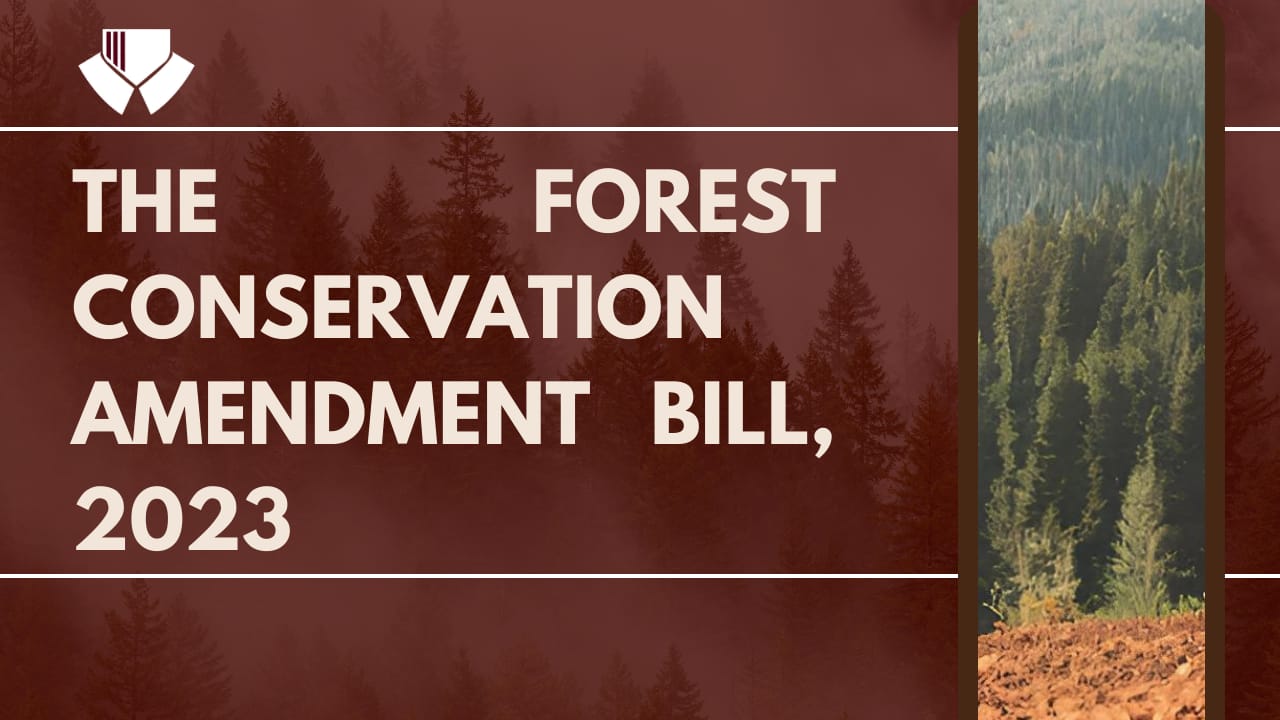THIS BLOG IS WRITTEN BY SAHI SANTOSH PAGUI, A STUDENT OF V.M. SALGAOCAR COLLEGE OF LAW, GOA.
INTRODUCTION:
The Forest (Conservation) Act of 2023, is an Indian legislation that aims to provide for the conservation of forests and wildlife in the country. The primary objective of this act is to regulate the diversion of forest land for non-forest purposes, such as industrial projects, mining, infrastructure development, etc. The act requires prior approval from the central government for such diversions.
LEGISLATIVE HISTORY:
The Forest (Conservation) Act is a significant piece of legislation in India aimed at conserving forests and wildlife. The history of the act can be understood within the context of growing concerns about deforestation and environmental degradation in the country. A general overview of the history leading up to the enactment of the Forest (Conservation) Act includes early concerns about deforestation, which includes early recognition of the importance of forests for various ecological, economic, and cultural reasons. However, during the post-independence period, there was a noticeable increase in deforestation due to various factors, including industrialization, urbanization, agricultural expansion, and developmental projects. A shift in approach was witnessed in the 1970s, as awareness about environmental issues grew, there was an increasing realization that unchecked deforestation could lead to ecological imbalances, loss of biodiversity, and other negative consequences. This realization prompted the Indian government to consider stricter measures for forest conservation. However, against this backdrop, the Forest (Conservation) Act was enacted by the Indian Parliament in 1980. The primary objective of the act was to regulate the diversion of forest land for non-forest purposes, such as industrial projects, mining, and infrastructure development.
OBJECT AND NEED OF THE ACT:
The Forest (Conservation) Act, 1980, was enacted in India with the primary objective of conserving and protecting the country’s forests and wildlife. The act addresses the need to balance the imperative for development and economic growth with the necessity of preserving valuable forest ecosystems, biodiversity, and ecological stability. Here are the main objectives and needs that the act aims to address:
- Conservation of Forests: The act was introduced to prevent the indiscriminate diversion of forest land for non-forest purposes, such as industrial projects, mining, and infrastructure development. It is crucial to prevent deforestation and the degradation of forest ecosystems.
- Biodiversity Protection: Forests play a vital role in maintaining biodiversity by providing habitats for various plant and animal species. The act recognizes the need to protect these habitats to ensure the survival of diverse species and maintain ecological balance.
- Erosion Control and Watershed Management: Forests contribute to soil conservation and water retention, which are essential for preventing soil erosion, maintaining water quality, and ensuring the sustainability of water resources. The act helps safeguard these functions.
- Climate Change Mitigation: Forests act as carbon sinks, absorbing and storing carbon dioxide from the atmosphere. By conserving forests, the act indirectly contributes to mitigating climate change by reducing greenhouse gas emissions.
- Cultural and Socioeconomic Importance: Forests have cultural, spiritual, and socioeconomic significance for many communities in India. The act recognizes the importance of preserving these aspects while managing forest resources sustainably.
- Protection of Wildlife: The act seeks to safeguard wildlife habitats and corridors, promoting the conservation of endangered and vulnerable species. Many forests are home to unique and rare wildlife that need protection from habitat destruction.
- Sustainable Development: The act acknowledges the need for development projects but emphasizes that these projects should not come at the expense of irreversible damage to forest ecosystems. By requiring prior approval for forest land diversion, the act encourages a balanced approach to development.
- Compensatory Afforestation: Addressing the loss of forest land due to development, the act mandates compensatory afforestation—planting trees on non-forest land to offset the ecological impact of forest land diversion.
- Regulation and Oversight: The establishment of the National Board for Wildlife and the requirement for central government approval for forest land diversion ensure a regulatory mechanism to scrutinize and assess the environmental impact of proposed projects.
EXTENT OF APPLICATION OF ACT:
- Territorial Extent: The act is applicable across the entire geographical area of India, covering all states and union territories. It is not restricted to specific regions or areas.
- Applicability to Forest Land: The act primarily pertains to forest land, which includes land recorded as forest in government records as well as any land that is deemed to be forest land through notification by the state government. The act is intended to prevent the diversion of such forest land for non-forest purposes.
- Prior Approval for Diversion: The key application of the act is the requirement for prior approval from the central government before any forest land can be diverted for non-forest purposes. This applies to projects such as mining, industrial development, infrastructure, and other activities that involve the use of forest land.
- Compensatory Afforestation: The act also mandates the practice of compensatory afforestation. When forest land is diverted for non-forest purposes, the entity seeking diversion is required to undertake compensatory afforestation over an equivalent area of non-forest land. This aims to mitigate the ecological impact of the land diversion.
- National Board for Wildlife: The act establishes the National Board for Wildlife, which plays a significant role in approving proposals for the diversion of forest land in and around national parks and wildlife sanctuaries. This adds an extra layer of oversight and scrutiny to ensure that wildlife habitats are safeguarded.
- Enforcement and Penalties: The act also includes provisions for penalties in cases of violations. Unauthorized diversion of forest land or failure to comply with the conditions of diversion can lead to penalties, which may include imprisonment.
- Applicability to States: While the Forest (Conservation) Act is a central part of legislation, the state governments play a crucial role in its implementation. State governments are responsible for preparing proposals for forest land diversion, which are then submitted to the central government for approval.
PROVISIONS AND SALIENT FEATURES:
| Sr. No. | SECTION | PROVISION |
| 1. | Section 2 | Insertion of a new Preamble highlighting importance of forests. |
| 2. | Section 3 | Renaming of the Act to “Van (Sanrakshan Evam Samvardhan) Adhiniyam”. |
| 3. | Section 4 | New Section 1A(1): Defines lands covered under the Act. |
| 4. | Section 5(a)(I) | Amends definition of “non-forest purpose” in Section 2. |
| 5. | Section 5(a)(II) | Expands list of forestry activities excluded from “non-forest purpose”. |
| 6. | Section 5(b) | Allows Central Gov. to specify terms for surveys as not “non forest purpose”. |
| 7. | Section 6 | New Section 3C: Empowers Central Gov. to issue directions for implementation. |
CONCLUSION:
The Forest (Conservation) Act of 2023 stands as a significant milestone in India’s efforts to strike a balance between environmental conservation and developmental needs. Enacted with the overarching objective of safeguarding the nation’s invaluable forest ecosystems and biodiversity, the act has outlined a comprehensive framework to regulate the diversion of forest land for non-forest purposes.


